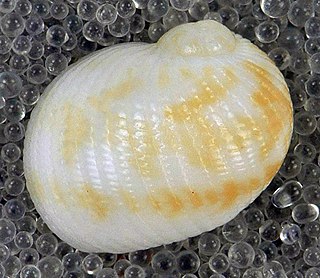Related Research Articles
Centemodon is an extinct genus of basal phytosaur from the Late Triassic Period. It lived in what is now Pennsylvania, United States. It is classified as a nomen dubium. It was found in the Red Sandstone Formation near the Schuyklill River. Centemodon may have been related to Suchoprion. It was a small phytosaur, weighing no more than 200 kilograms (440 lb) when fully grown.

The groove-billed toucanet is a species of bird in the family Ramphastidae. It is found in mountains of north-eastern Colombia and northern Venezuela. Its natural habitat is subtropical and upper tropical humid forest and woodland, occasionally also occurring in gardens.
Gonidomus sulcatus is a species of air-breathing land snail, a terrestrial pulmonate gastropod mollusk in the family Streptaxidae.

Penion sulcatus is a species of medium-to-large predatory marine snail or whelk, commonly called the northern siphon whelk or kākara nui in Māori, belonging to the true whelk family Buccinidae.

Homosteus is a genus of flattened arthrodire placoderm from the Middle Devonian. Fossils are found primarily in Eifelian-epoch aged strata of Europe, Canada, Greenland, and Estonia. All of the species had comparatively large, flattened heads with, as suggested by the upward opening orbits, upward-pointing eyes. These adaptations suggest that the various species were benthic predators. A study on Titanichthys, in contrast, suggests that species of Homosteus may have been filter-feeders instead.

Otiorhynchus is a large genus of weevils in the family Curculionidae. Many species of the genus, particularly the black vine weevil and the strawberry root weevil, are important pests, both as larvae and as adults. Larvae feed on plant roots. Adults are flightless with fused elytra and feed at night on plant foliage. In many species of the genus at least some races are polyploid and parthenogenetic, while the rest of the races and species are diploid and bisexual. Otiorhynchus weevils, particularly O. scaber, have been a popular subject for studies of the evolution of parthenogenesis. The genus is native to the Palearctic region. However, sixteen species were inadvertently introduced to North America and have become widespread there.

Euastacus sulcatus, also known as the Lamington crayfish, is a freshwater crayfish, or "yabby", native to Australia. It is commonly bright blue in colour and roams the forest floor when conditions are damp. Red and white colour variants also exist.

Acilius sulcatus is a species of water beetle in family Dytiscidae.It is fairly large, with color variation shown throughout its range. Typically it is yellow and black.

Planaxis is a genus of small sea snails, marine gastropod mollusks in the family Planaxidae.

Stigmaulax sulcatus is a species of predatory sea snail, a marine gastropod mollusk in the family Naticidae, the moon snails.

Stigmaulax is a genus of predatory sea snails, marine gastropod mollusks in the family Naticidae, the moon snails.
Corybas sulcatus, also known as the grooved helmet-orchid, is one of two helmet orchids endemic to Australia’s subantarctic Macquarie Island, and the second to be discovered. The specific epithet comes from the Latin sulcatus – “grooved”, with reference to the prominent groove in the labellum boss. It is a small, terrestrial, tuberous, herbaceous plant that forms clonal colonies. The flower is erect, mostly dark red, 25–30 mm long and 10–14 mm wide. The flowering period is November–December. It occurs on the plateau uplands of the island, growing in wet grassy seepage areas. It can be distinguished from the only other orchid on the island, Corybas dienemus, by its dark red flowers.
Copelatus sulcatus is a species of diving beetle. It is part of the subfamily Copelatinae in the family Dytiscidae. It was described by Sharp in 1882.
Grasseella is a genus in the phylum Apicomplexa.
Schizodelphis is an extinct genus of cetacean.
Crinotarsus is a genus of longhorn beetles of the subfamily Lamiinae.
Crinotarsus plagiatus is a species of beetle in the family Cerambycidae. It was described by Blanchard in 1853.

Hakea sulcata, commonly known as furrowed hakea, is a flowering plant in the family Proteaceae and is endemic to Western Australia. It is a prickly shrub with grooved, cylindrical leaves, sweetly-scented flowers and relatively small fruit.
Prohegetotherium is an extinct genus of mammals from the Late Oligocene of the Agua de la Piedra, Mariño & Sarmiento Formations of Argentina, the Salla Formation of Bolivia, and Fray Bentos Formation of Uruguay.
Taphrosphys is an extinct genus of bothremydid pleurodiran turtle that was discovered Angola, Morocco and the United States. The genus consists of type species T. sulcatus, T. ppolitoi, T. congolensis, and the dubious T. dares.
References
- ↑ BioLib.cz - Crinotarsus sulcatus. Retrieved on 8 September 2014.